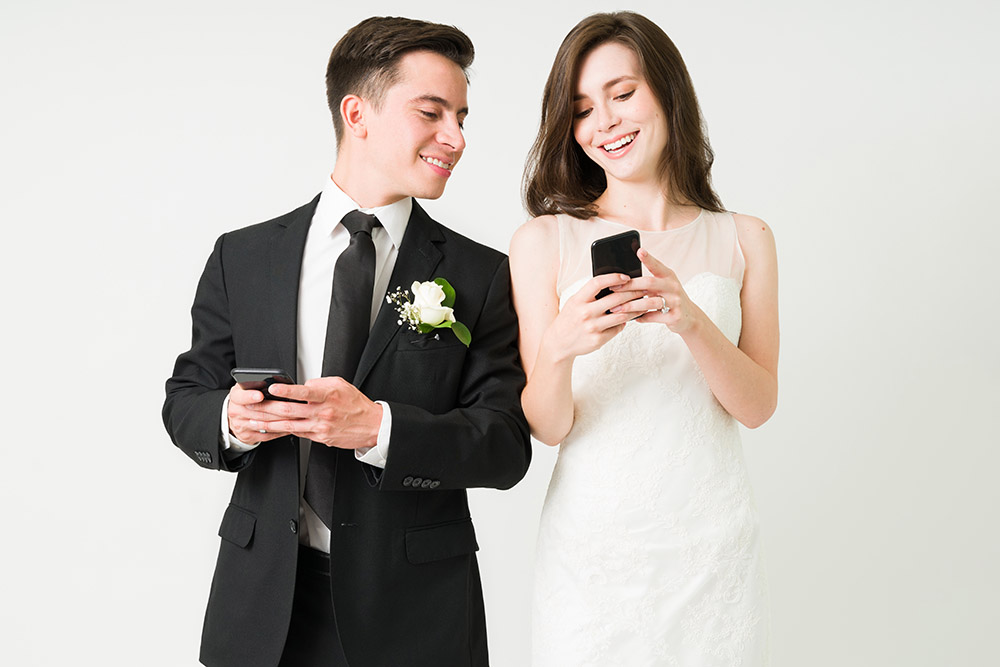Reel Weddings?

WRITTEN BY: Jessica Burke
It’s no secret that there is usually a wait to get your professional wedding photos and video after your wedding. In this world of instant gratification, it can be oh-so-hard to be patient even though we KNOW it’s worth every second of the wait!
If you know that patience is not one of your finer virtues, you can always ask your wedding guests to send you whatever photos or videos they capture or assign a member of the wedding party to follow you around with their phone.
But let’s be real. You invited your guests (including your wedding party) to be present in the moment with you. And let’s be even more real: it’s not unheard of that a well-intentioned but oblivious wedding guest has wandered into a pro photographer or videographer’s frame and ruined their shot of a once-in-a-lifetime moment.
Fortunately you can get that instant gratification you crave without turning your guests into free labor or risking ruining the professional photos and video you’ve invested so much money in.
How? I’m glad you asked: by hiring a social media specialist to cover your wedding alongside your photographer and videographer.
I sat down recently with Amanda Bravender of The Social Confidant who specializes in this exact service.
Amanda, who began her wedding career 15 years ago in the beauty realm, found her recent clients asking for her help filming TikToks and Reels after she finished their wedding hair and makeup. As an avid social media creator, she was happy to help her brides create these videos. “I love helping create this fun content and realized that this was a service that couples might be interested in booking for their weddings,” she says. “This way you’re not on your phone all day, your bridesmaids aren’t on their phones all day – they can put it away and let me do it for them.”
Amanda notes that her services aren’t intended to replace a professional photographer or videographer, but to complement what they’re doing and get shots they don’t have time for, like filming trending dances to post specifically to TikTok and Instagram. In fact, she often finds herself working for other wedding pros. “I’m often hired by photographers,” she says. “You can never have enough content.”
Amanda coordinates with her social media clients ahead of the wedding to make sure she knows what is most important for them. She sends out a questionnaire and asks for their top 3 video concepts. “We try to hit your goals for you. You want to do it all, but you can’t do it all,” she says of the number of TikTok trends at any given moment. “Sometimes we take video footage and make something entirely different.”
With trends changing by the second, it’s best to wait til closer to your wedding to decide what dances and transitions to film. “For most couples, I ask the week before,” she says. “Things are changing constantly and it’s the only way to do it with social media.”
Some shots that have been fairly popular are transitions, including hair and makeup before and afters or wedding pjs to wedding dress videos, sweet moments on the altar, process photos of the photographer posing the couple paired with the final edited photo, partying shots on the way to the wedding, fun moments at the reception and silly reels.
Amanda’s advice for anyone wanting to recreate a viral TikTok or Reel?
If you want to do a trending dance, “You have to practice ahead of time,” she says.
If you have a favorite audio or concept, hit the “save” button so you can find it later when you’re ready to post. The chances of finding that audio when you’re ready to use it are slim if you haven’t saved it.
The benefits of having a social media specialist on your wedding day go beyond just having instant content; it’s also great for connecting with family and friends who can’t make it to the wedding. They can post throughout the day to your account (even going live if you want that!) and at the end of the night, share all the raw photos and videos they captured directly with you.
You can start reliving your wedding instantly and share your day with the world before you even make it to your honeymoon!

When a photographer looks through the viewfinder of a film camera and decides to snap a shot, something magical happens. The entire world slows down. Breath becomes intentional, movements are deliberate. The moment being captured in front of the lens feels momentarily frozen in time. Film photographers must engage with these moments organically, while also contemplating so many other factors such as light, composition, motion, and emotion. Each image created on film has a unique story behind it—one that is attained through careful consideration to each elemental step: removing the dark slide, manually focusing and exposing, making sure the film is advancing properly, selectively opening the shutter, and staying conscious about making the limited film shots COUNT!
“Each image created on film has a unique story behind it—one that is attained through careful
consideration.”

While digital photography has come a long way in perfecting the look of an image and making it easier for photographers to get the “PERFECT SHOT,” film is not about perfection. On film cameras, there are no reference monitors to confirm that the exposure and focus are accurately set; there are no automatic settings. There is no guessing with shooting film—you have to know what you’re doing. This artistic medium requires a high level of skill, experience, and consciousness. For this reason, the margin for error is so much higher when shooting film, which makes the reward that much greater. Of course, mistakes can be made. Photographs can be out of focus, underexposed or overexposed, which cannot be fixed in post-production. Yet, these perfectly imperfect mistakes are the essence of film and what differentiates it from picture-perfect digital.

The invention of the film camera traces back to the 18th century; yet, there was a turning point at the beginning of the 21st century when digital photography made a monumental surge moving film cameras to the back seat. This surge created a paradigm shift in how to approach photography. The ease of use and automatic settings of a digital camera allowed for an explosion of new photographers.
Digital cameras provided a much higher picture count and rear LCD screens, which allowed photographers immediate gratification or correction of a shot and thereby reduced the margin of error. Storage of digital files took up less physical space and were able to be distributed seamlessly via email and text message. Despite these clear advantages, digital images often lack depth and tangibility. The subjects look flat in comparison to the depth of a film negative.
Depth is what gives film so much existence. A film image places the viewer right back in the scene of the photograph, which is the reason that film is inherently nostalgic.
“A film image places the viewer right back in the scene of the photograph, which is the reason that film is inherently nostalgic.”
Wedding photos are meant to evoke feelings of nostalgia because of the nature of the event, and the significance behind the celebration. Unlike digital photography, film photography has the character and integrity to match the energy of such an occasion.
Personally, I like the idea of shooting a wedding in both mediums (film and digital), leaning heavily into digital for documentation and film to create art. What is important when hiring a photographer, regardless of what medium resonates with you, is how the photographer is managing and archiving the photographs. The process of handling digital files versus film negatives is very different.
For example, with film, a tangible negative will always be the source of the original image; whereas with digital, the original image lives on a hard drive or in cloud storage. Film negatives are now scanned into a digital file creating a duplicate copy of the image (both tangible and digital).
Clients are obviously concerned with the safety and protection of their wedding photos for years beyond the wedding date, so making sure these images are safe should be a top priority.
 Another consideration is the desired style of the end product. Over-processed digital images lose integrity and are restricted by the whims of digital technology.
Another consideration is the desired style of the end product. Over-processed digital images lose integrity and are restricted by the whims of digital technology.
A film negative, however, lives in the real world. Properly processed film negatives do not require any real post processing and can be made into large-formatted prints without compromising image quality.
In the end, the goal is always to provide clients with a gallery of images that represents their day as it truly was, in the most authentic, creative way.
I’ve been in the wedding photography industry for over 40 years, having been raised by parents who documented thousands of weddings in the New Orleans area. My mother used to tell me, “there’s nothing like the integrity of a film image. It is true to life.”
As a child, being born in film but living in digital, my passion for film photography is rooted in my time loading film backs and counting shots when shooting weddings with my dad before the age of 12. I learned from my dad at a very early age that having a working knowledge of a camera and being present with the subject is such an important skill for any type of photographer. My parents used to tell me, “make them love a picture before they see a picture.” This is something I never forget!
Photography is a craft which requires more than just a working knowledge of a camera. It requires an ability to connect with the couples, the families, the planners, and other artists/vendors involved in order to tell the most compelling story of any wedding.
Film is here to stay, but at a premium. The experience needed, along with the rising costs of acquiring and developing film, are making it a niche market that only some people may feel connected to, or are able to afford.
So, on your wedding day, whether you decide to hire a digital photographer, a film photographer or a photographer who can provide you with both mediums, make sure you invest in a professional.
Look beyond a few great photos on a website or an Instagram feed and search for a professional that fully understands all aspects of providing first class service, a great product and a fool proof archival system of your images.
Digital photography isn’t going anywhere, but neither is film.
Related Posts
- Like
- Digg
- Tumblr
- VKontakte
- Buffer
- Love This
- Odnoklassniki
- Meneame
- Blogger
- Amazon
- Yahoo Mail
- Gmail
- AOL
- Newsvine
- HackerNews
- Evernote
- MySpace
- Mail.ru
- Viadeo
- Line
- Comments
- SMS
- Viber
- Telegram
- Subscribe
- Facebook Messenger
- Kakao
- LiveJournal
- Yammer
- Edgar
- Fintel
- Mix
- Instapaper
- Copy Link






Comments (0)